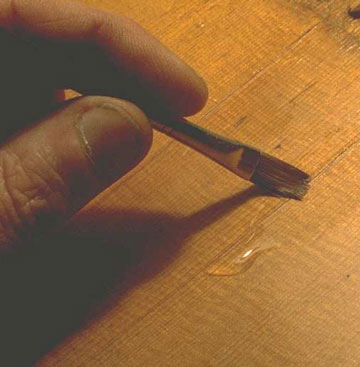Deionized Water
© Frank Ford, 8/10/99; Photos by FF, 8/10/99
I learned about deionized water from my friend, Joe Grubaugh, the violin maker and restorer. He's always saying, "we're constantly searching for more ways do do less. Deionized water is what we're using instead of bleach to clean out the dirt from cracks."
So what is the stuff? Well, it's just good old H2O, distilled and run through activated carbon filtration to neutralize any electric charge. This purified distilled water has no charge, and won't conduct electricity. I understand it, deionized water is highly attractive to dirt molecules, which will have either a positive or negative charge of their own. Hungry as it is to attract ions, deionized water remains pure only as long as it's in its original container and not open often or for prolonged periods.
The stuff comes from chemical supply houses, and isn't particularly expensive, as chemicals go:

For use in instrument repair, it is best to buy deionized water in the smallest containers possible. This is a gallon jug, but I'd have been lots better off getting pints, because I'd only used a small portion of it before it became "contaminated" just from being opened.

I use deionized water only for cleaning the dirt out of cracks in light colored spruce tops, or for blond maple. It works reasonably well to clean off the dirt, but I have to keep a flow of the water going as I scrub with a fine watercolor brush to massage the dirt out of the cracks.
I called around locally to specialty purified water suppliers. One chemist I talked to said that lots of supermarkets sell a really pure deionized water from those big coin operated machines where you bring your own jug to fill up. I haven't tried it yet, but it seems like a good possibility.
This is the sort of thing that is appropriate when there's good access to the interior of the crack, and where the repair budget will allow the luxury of extra time.

Then, after the area dries thoroughly and I glue up the crack with good, clear, non-staining hide glue, I get a much less visible glue line. Dirt in the crack tends to turn really black when glued because the clear glue acts a little like a lens to conduct light down into the crack.
So, while I may not know much about the chemistry involved, I can say that I get better results from deionized water than any other technique for cleaning dirt out of cracks. It doesn't work well all the time, but it's usually worth a try.
Back to Index Page